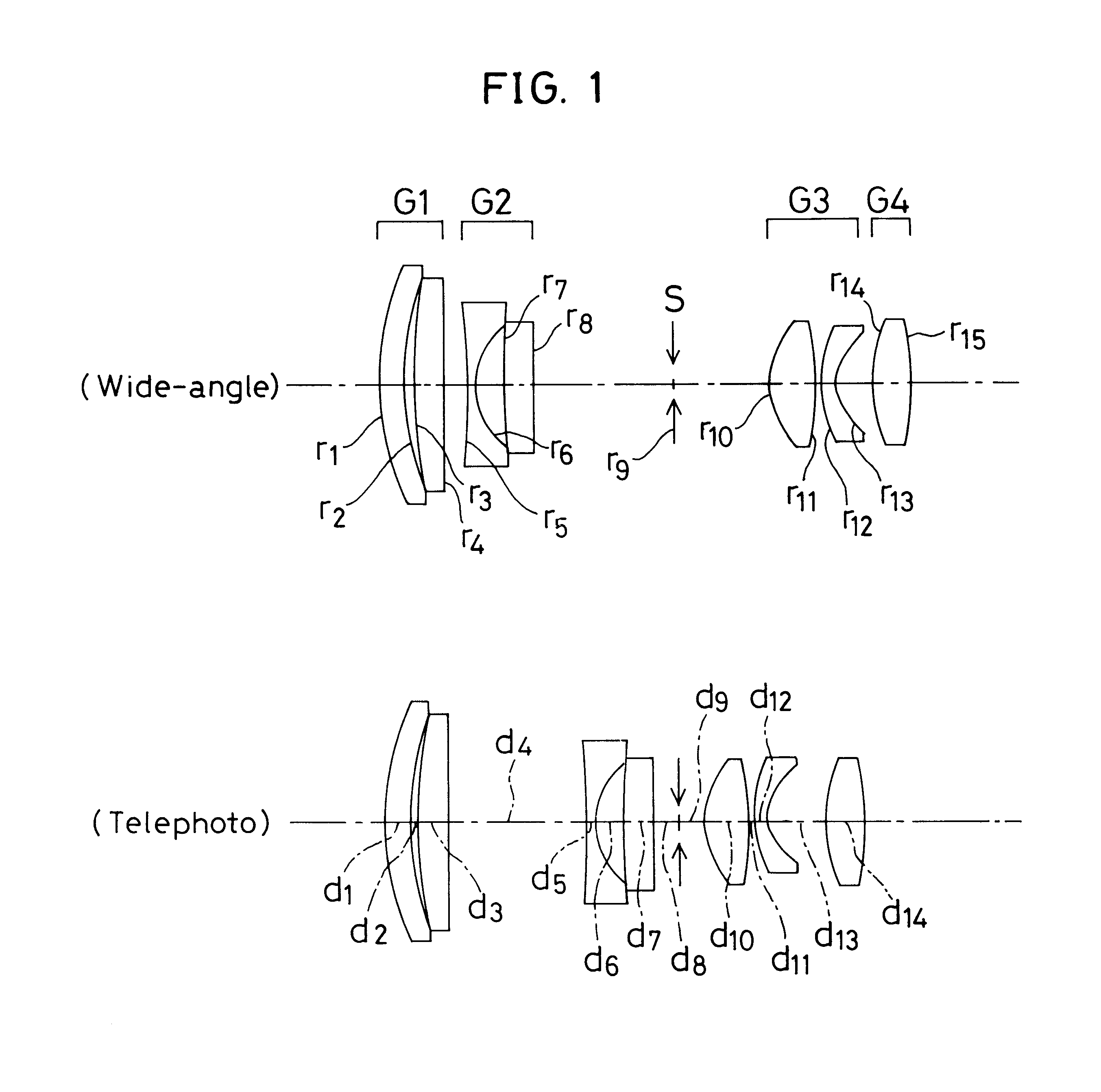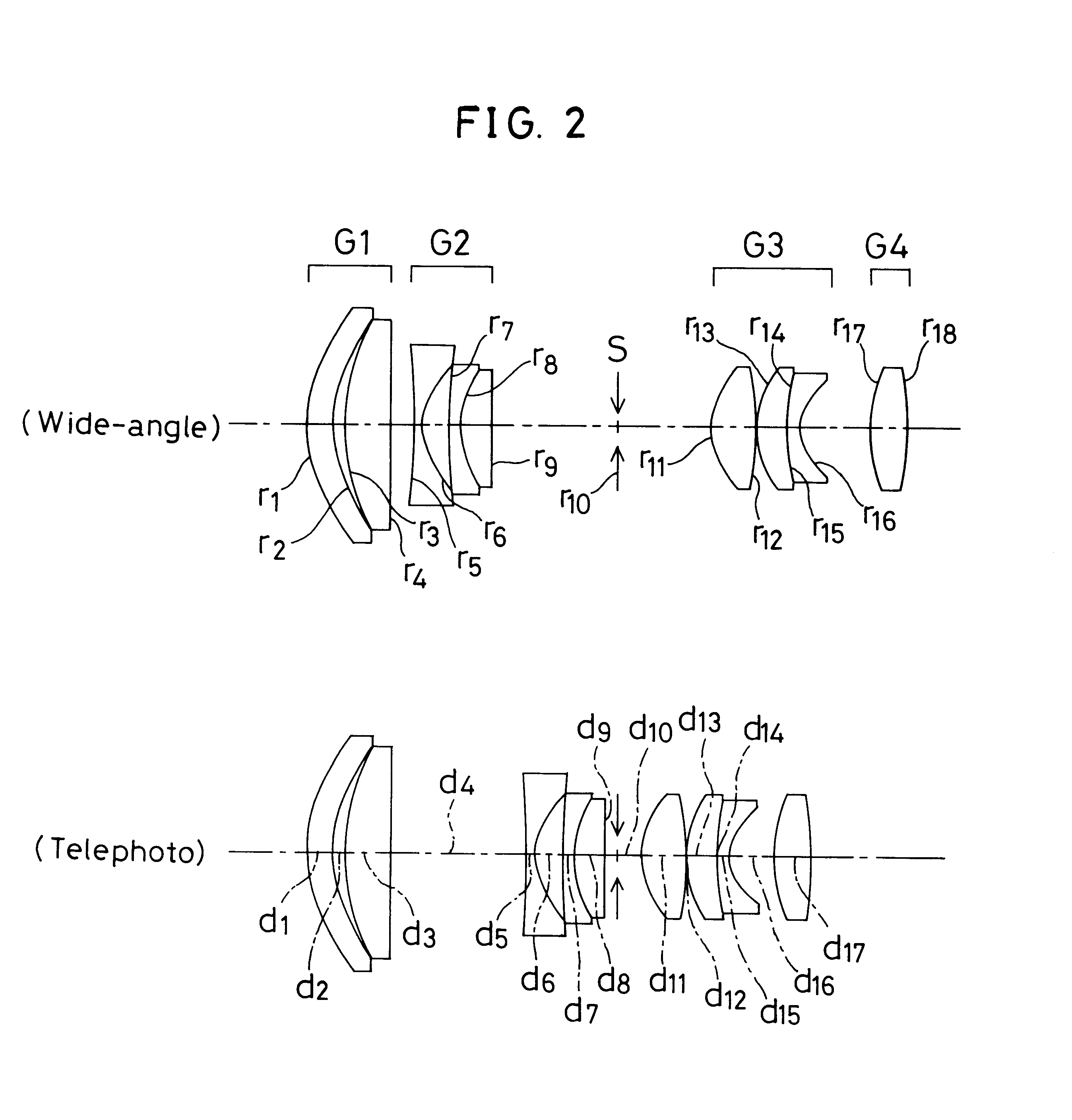Zoom lens system
a zoom lens and lens diameter technology, applied in the field of zoom lens systems, can solve the problems of difficult to achieve a further reduction in the diameter of the lens, insufficient zoom lens systems for zoom lens systems having a lower zoom ratio, and large siz
- Summary
- Abstract
- Description
- Claims
- Application Information
AI Technical Summary
Benefits of technology
Problems solved by technology
Method used
Image
Examples
example 7
is directed to a zoom lens system having a focal length of 5.50 to 15.75 and a field angle of 66.42.degree. to 24.degree.. As illustrated in FIG. 7, a first lens group G1 is made up of a doublet consisting of a negative meniscus lens convex on an object side thereof and a double-convex lens, and a positive meniscus lens convex on an object side thereof. A second lens group G2 is made up of a negative meniscus lens convex on an object side thereof and a doublet consisting of a double-concave lens and a double-convex lens. At the rear of the second lens group G2 there is located a stop S. A third lens group G3 is made up of two double-convex lenses, and a negative meniscus lens convex on an object side thereof, and a fourth lens group G4 is made up of one positive meniscus lens convex on an object side thereof. An aspherical surface is used for a surface in the third lens group G3 that is located nearest to the object side. For zooming from the wide-angle end to the telephoto end, whi...
example 8
is directed to a zoom lens system having a focal length of 5.52 to 15.91 and a field angle of 67.04.degree. to 23.72.degree.. As shown in FIG. 8, a first lens group G1 is made up of a doublet consisting of a negative meniscus lens convex on an object side thereof and a positive meniscus lens. A second lens group G2 is made up of a negative meniscus lens convex on an object side thereof, a double-concave lens, and a positive meniscus lens convex on an object side thereof. At the rear of the second lens group G2 there is located a stop S. A third lens group G3 is made up of two double-convex lenses, and a negative meniscus lens convex on an object side thereof, and a fourth lens group G4 is made up of one double-convex lens. An aspherical surface is used for the surface in the third lens group G3 that is located nearest to the object side. For zooming from the wide-angle end to the telephoto end, while the first lens group G1 and the stop S remain fixed, the second lens group G2 moves...
example 9
is directed to a zoom lens system having a focal length of 5.50 to 15.81 and a field angle of 66.82.degree. to 23.88.degree.. As can be seen from FIG. 9, a first lens group G1 is made up of a doublet consisting of a negative meniscus lens convex on an object side thereof and a double-convex lens. A second lens group G2 is made up of a double-concave lens and a positive lens, and at the rear thereof there is located a stop S. A third lens group G3 is made up of a double-convex lens, a positive meniscus lens convex on an object side thereof, and a negative meniscus lens convex on an object side thereof, and a fourth lens group G4 is made up of one positive meniscus lens convex on an object side thereof. Three aspherical surfaces are used, one for the surface in the second lens group G2 that is located nearest to the image plane side, one for the surface in the third lens group G3 that is located nearest to the object side, and one for the surface in the fourth lens group G4 that is lo...
PUM
 Login to View More
Login to View More Abstract
Description
Claims
Application Information
 Login to View More
Login to View More - R&D
- Intellectual Property
- Life Sciences
- Materials
- Tech Scout
- Unparalleled Data Quality
- Higher Quality Content
- 60% Fewer Hallucinations
Browse by: Latest US Patents, China's latest patents, Technical Efficacy Thesaurus, Application Domain, Technology Topic, Popular Technical Reports.
© 2025 PatSnap. All rights reserved.Legal|Privacy policy|Modern Slavery Act Transparency Statement|Sitemap|About US| Contact US: help@patsnap.com



